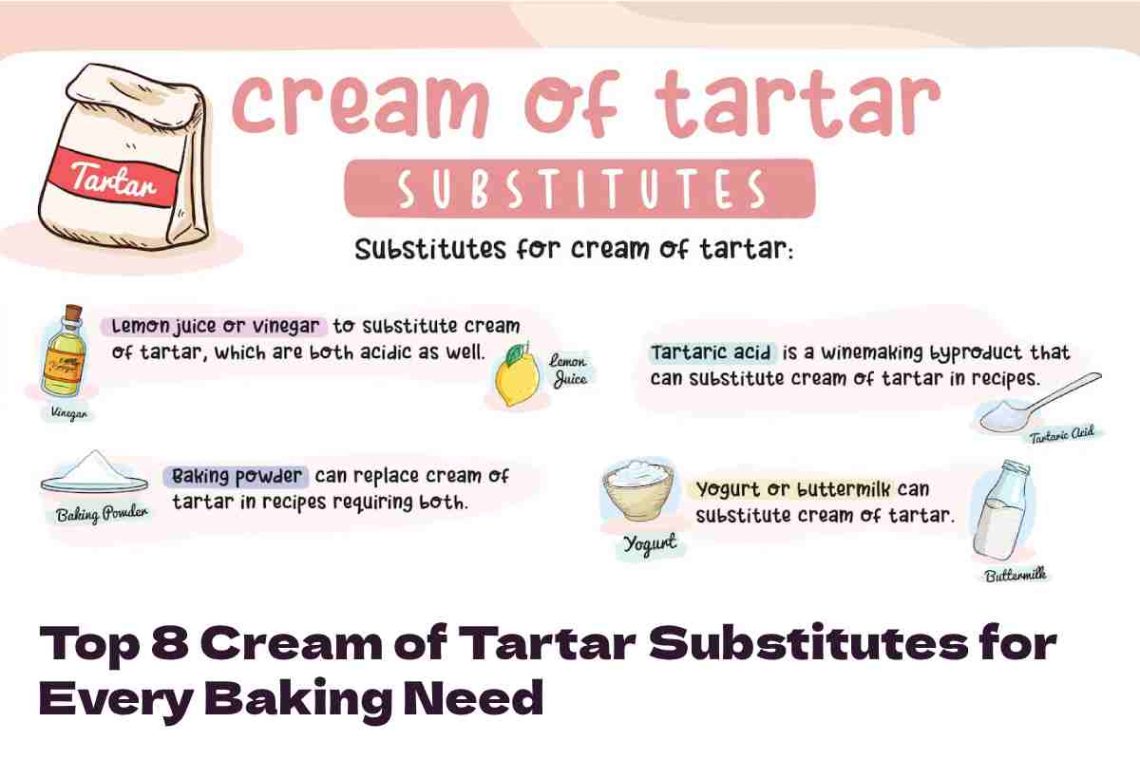Cream of tartar is an ingredient frequently found in baking recipes. It is sold as a fine powder and can boost cakes, creams, and meringues. Below, we will explain what cream of tartar is, its purposes in cooking, and what cream of tartar substitute is.
What is a cream of tartar?
Cream of tartar is a powdered baking ingredient with no taste or smell. Its primary capability is to balance fats and the right acidity, two properties exceptionally valued in preparing icings, baked goods, cakes, egg products, and certain drinks.
It is called potassium bitartrate or potassium acid tartrate and white cream in some regions. Tartars are potassium salts obtained from tartaric acid, a compound obtained from the maturation of grapes and berries. Truthfully, the industrially accessible cream of tartar is a result of wine creation.
Cream of tartar substitutes
What do I do if I don’t have cream of tartar? That is no problem because there are many possibilities for replacing cream of tartar when making homemade pastries. If the recipe only needs cream of tartar but has baking soda, we can replace it with:
Here are some Cream of tartar substitutes
| Substitute | Effective Substitute | Notes |
| Lemon Juice | True | Use double the amount of lemon juice compared to cream of tartar. Ideal for lemon-flavored recipes. |
| White Vinegar | True | Use triple the amount of vinegar compared to cream of tartar. Avoid chocolate recipes due to flavor impact. |
| Baking Powder | True | Use baking powder in place of cream of tartar and baking soda combined. Suitable for cookies and cakes. |
| Buttermilk | True | Replace cream of tartar with buttermilk and adjust other liquids in the recipe. Best for baked goods. |
| Yogurt | True | Thin yogurt with milk and use it similarly to buttermilk. Adjust other liquids in the recipe. Suitable for baked goods. |
| Cream of Lemon | True | A commercial product specifically made to substitute cream of tartar is available in some stores. |
| Kefir | True | Similar to buttermilk, kefir can replace cream of tartar. Adjust other liquids in the recipe. Contains probiotics. |
| Sour Cream | True | Sour cream can be used similarly to buttermilk or yogurt. Adjust other liquids in the recipe. |
| Whipped Egg Whites | Potentially True | It can sometimes replace the stabilizing effect of cream of tartar when making meringues or soufflés but may require additional handling. |
| Acidic Fruit Juices | Potentially True | Juices like pineapple or orange can replace the cream of tartar in some recipes. Consider flavor impact. |
What is the cream of tartar used for, and how is it used in the kitchen?
Cream of tartar, which has nothing to do with tartar sauce, gives fluffiness to cakes and biscuits, leaven cookies, provides creaminess, achieves the best frosting, and an unforgettable meringue. As a bonus, it also acts as a natural preservative and acidity regulator, which is why it is present in drinks, soft drinks, pastries, and many other industrial foods.
How can we use cream of tartar at home?
Cream of tartar, unrelated to tartar sauce, gives fluffiness to cakes and rolls, raises treats, adds richness, makes the best frosting, and creates an extraordinary meringue. As a bonus, it also acts as a natural preservative and acidity regulator, which is why it is present in drinks, soft drinks, pastries, and many other industrial foods.
To increase the fluffiness of our cakes and biscuits, add ¼ teaspoons of cream of tartar to the flour used in our recipe, alongside a portion of the baking soda. It will give us a light and delicate batter.
Cream of tartar is also essential for making meringue. It’s as simple as adding 1 teaspoon of coffee for each 4 egg whites. The subsequent meringue will be voluminous and have an ideal surface with an unbeatable balance between nearly crunchy and delicate.
To leave our cookies, we can make our baking powder by blending 2 teaspoons of tartar cream with 1 teaspoon of baking soda. The combination releases carbon dioxide to behave like some other leaving specialist, allowing us to enjoy crispy cookies for longer.
For glazes, adding ¼ teaspoons of cream of tartar will keep the sugars from solidifying excessively. It will give you the best surface to improve, spread, or wrap in the glaze without it becoming petrified. If we are talking about savory dishes, adding cream of tartar to our sauces is a great idea to keep them creamy for much longer.
Other tips
You can omit the cream of tartar in meringue recipes, but the eggs will have to be beaten more to be more stable.
If you use vinegar or lemon, it can change the flavor, making it more acidic. In that case, you must add more sugar to counteract it.
You can omit the cream of tartar in lemon cakes or pies, such as the lemon meringue pie we propose, since the flavor is already present and will not be a problem.
Conclusion
In conclusion, using a Cream of Tartar substitute can be a simple and effective way to achieve similar results in baking and cooking. Whether you choose lemon juice, white vinegar, or baking powder, each option works well depending on the recipe’s needs. While the flavor or texture may vary slightly, these alternatives ensure your dish maintains its rise, stability, and consistency even without the original ingredient. Having a reliable Cream of Tartar substitute on hand can save time and keep your culinary creations perfectly balanced.

